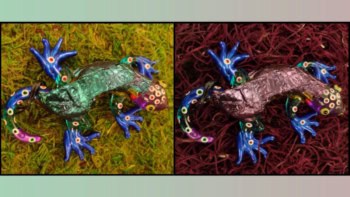
Microscopic oil droplets held aloft with optical tweezers can contain more than 200 resonant optical modes of similar energies, creating “hyperdegeneracy” for the first time. That is the claim of researchers in Israel, Spain and the US, who say that their breakthrough could ultimately find application in high-speed optical communications, sensing, quantum data processing and even the creation of dynamic optical circuits.
When optical materials with a high refractive index are formed into certain symmetrical shapes — such as rings, cylinders or spheres —light can be repeatedly reflected around the inside of the material, much in the same way that sound waves pass around the inside edge of St Paul’s Cathedral’s famous “whispering gallery”. The circulating light undergoes constructive interference, forming discrete resonant modes – or so-called degenerate states – with similar energies.
The number of modes is dependent on the ratio between the light’s wavelength and the circumference of the resonator — meaning that, in theory, a spherical object with a circumference tens of microns in size could support hundreds of modes of either visible or near-infrared light. In practice, however, achieving such hyperdegeneracy has proven impossible with conventional fabrication techniques. This is because even a single stem supporting the sphere will reduce the object’s symmetry and thereby reduce the extent of the potential degeneracy.
Clean and unscratched
In a new study, however, mechanical engineer Tal Carmon of the Technion-Israel Institute of Technology and his colleagues have circumvented this issue by supporting a 10 micron spherical droplet of silicone oil within an optical tweezer, thereby removing the need for a disruptive structural support. In fact, the radiation pressure from the laser-based tweezers acts to almost completely preserve the spherical symmetry of the oil droplet – along with the potential for hyperdegeneracy. In addition, the researchers explain, the levitation keeps the surface of the microresonator clean and unscratched.
Writing in the journal Physical Review X ,they say “unlike solids, the liquid droplet does not contain any dislocation, inclinations, and thermally induced stresses, which are typical for solid resonators and reduce their quality”.
To reveal the modes, the team placed a tapered fibre close to the surface of the oil microsphere and passed near-infrared laser light into and out of the droplet by means of an evanescent coupling. In the resulting transmission spectrum, the team observed signals of more than 200 modes – the largest-recorded set of degenerate states to ever be measured. The modes did exhibit slight differences in energy; this was a product of the droplet not being perfectly spherical, but distorted slightly as a result of the pressure from the optical tweezers, the presence of the coupled fibre, and the effect of gravity.
Simulating atomic optics
The technology could have several practical applications, write Peking University physicists Qi-Tao Cao and Yun-Feng Xiao in a commentary on the Physical Review X paper. “As a mesoscopic analogue to a single atom, levitated microresonators could serve as well-controlled platforms for simulating atomic optics,” they explain. Other potential applications could lie in using single-photon versions of the resonators as qubits for quantum processing, the creation of malleable circuits using multiple droplets, and high-capacity optical communications through the use of different modes to form densely packed information channels.

How to make square-shaped droplets
Cao and Xiao also point out that the microspheres could be used in existing sensing applications. “The frequency of hyperdegenerate modes is extremely sensitive to external perturbation, and even a tiny [such disturbance] – such as a biomolecule near the resonator surface — could lead to measurable modulation [of the light modes]”.
Dmitry Skryabin at the University of Bath adds, “The extremely high degeneracy and ability to manipulate it for fundamental studies of many coupled oscillators in linear, nonlinear and quantum regimes links these results to many cross-area ideas”. “Ultra-high finesses and near degeneracies in resonators also link to the cross-disciplinary concept of Arnold tongues and oscillator synchronization in the context of frequency comb research.”



